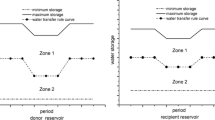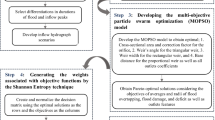Abstract
Hitherto, there has been insufficient work to quantify the degree of mutual feedback among the different objectives of multi-objective reservoir operation. The purpose of this study is to use a Multi-objective Correlation Index (MCI) to quantitatively analyze the complicated relationship of a multi-objective reservoir operation under changing inflow and water demands. First, an improved maximum probability density function method has been used to generate the adaptive ecological flow thresholds in long-term, wet-year, normal-year and dry-year inflow scenarios. Based on these ecological flow thresholds, a multi-objective reservoir optimal operation including the three objectives of power generation, water supply and ecology is constructed to research the tradeoff relationship among the objectives. Moreover, using the optimal solution set as determined by the Progressive Optimality Algorithm-Particle Swarm Optimization (POA-PSO) algorithm, the MCI is used to quantify the degree of the tradeoffs and their trends in responding to the changing conditions. The results show that the synergistic degree between the water supply and ecological objective decreases when the climatic condition changes from wet years to dry years, while the conflicting degree of power generation with respect to water supply or ecological objectives increases. Furthermore, the major degree of tradeoffs changes from the power generation-ecological flow objective pair to the power generation-water supply objective pair. In general, the MCI is able to quantify the extent and characteristics of the tradeoffs between different objectives. Hence, this index is useful for managers to make more informed and transparent decisions.





Similar content being viewed by others
Data Availability
Data available after request from the corresponding author.
References
Bai T, Wei J, Chang F, Yang W, Huang Q (2019) Optimize multi-objective transformation rules of water-sediment regulation for cascade reservoirs in the upper Yellow River of China. J Hydrol 577:123987
Bian J, Dong Z, Jia Y, Zhong D (2019) Research on the multi-objective optimal operation of cascade reservoirs in the upper and middle Yellow River basin. Water Sci Tech-W Sup 19(7):1918–1928
Chang F, Wang Y, Tsai W (2016) Modelling intelligent water resources allocation for multi-users. Water Resour Manag 30(4):1395–1413
Chen X, Xu B, Zheng Y, Zhang C (2019) Nexus of water, energy and ecosystems in the upper Mekong River: a system analysis of phosphorus transport through cascade reservoirs. Sci Total Environ 671:1179–1191
Chen X, Zheng Y, Xu B, Wang L, Han F, Zhang C (2020) Balancing competing interests in the Mekong River basin via the operation of cascade hydropower reservoirs in China: insights from system modeling. J Clean Prod 254:119967
Duan C, Chen B (2017) Energy–water nexus of international energy trade of China. Appl Energy 194:725–734
Eckart (2001) Evolutionary multi-criterion optimization. Springer, Verlag, Berlin
Fornaroli R, Cabrini R, Sartori L, Marazzi F, Canobbio S, Mezzanotte V (2016) Optimal flow for brown trout: habitat - prey optimization. Sci Total Environ 566:1568–1578. https://doi.org/10.1016/j.scitotenv.2016.06.047
Gonzalez JM, Olivares MA, Medellin-Azuara J, Moreno R, Marques G (2016) In: Pathak CS, Reinhart D (eds) Multi-purpose reservoir operation: a tradeoff analysis between hydropower generation and irrigated agriculture using hydro-economic models. American Society of Civil Engineers, New York, pp 241–250
Howson HR, Sancho NGF (1975) A new algorithm for the solution of multi-state dynamic programming problems. Math Program 8(1):104–116
Smakhtin VU (2001) Low flow hydrology: a review. J Hydrol 240(3–4):147–186. https://doi.org/10.1016/S0022-1694(00)00340-1
Tan G, Yi R, Chang J, Shu C, Yin Z, Han S, Feng Z, Lyu Y (2018) A new method for calculating ecological flow: distribution flow method. AIP Adv 8(4):45118. https://doi.org/10.1063/1.5022048
Tang R, Zhang C, Ding W, Li Y, Zhou H (2017) Use of multi-objective analysis to reveal the benefits of a water transfer project. Water Supply 17(1):259–266. https://doi.org/10.2166/ws.2016.132
Tang R, Ding W, Ye L, Wang Y, Zhou H (2019) Tradeoff analysis index for many-objective reservoir optimization. Water Resour Manag 33(13):4637–4651. https://doi.org/10.1007/s11269-019-02363-z
Tharme RE (2003) A global perspective on environmental flow assessment: emerging trends in the development and application of environmental flow methodologies for rivers. River Res Appl 19(5–6):397–441
Unal M, Warn GP, Simpson TW (2016) Quantifying tradeoffs to reduce the dimensionality of complex design optimization problems and expedite trade space exploration. Struct Multidiscip Optim 54(2):233–248. https://doi.org/10.1007/s00158-015-1389-7
Unal M, Warn GP, Simpson TW (2018) Quantifying the shape of Pareto fronts during multi-objective trade space exploration. J Mech Design 140:0214022. https://doi.org/10.1115/1.4038005
Vermeesch P (2012) On the visualisation of detrital age distributions. Chem Geol 312:190–194. https://doi.org/10.1016/j.chemgeo.2012.04.021
Wu L, Bai T, Huang Q (2020) Tradeoff analysis between economic and ecological benefits of the inter basin water transfer project under changing environment and its operation rules. J Clean Prod 248:119294. https://doi.org/10.1016/j.jclepro.2019.119294
Xu W (2020) Study on multi-objective operation strategy for multi-reservoirs in small-scale watershed considering ecological flows. Water Resour Manag. https://doi.org/10.1007/s11269-020-02685-3
Xu J, Ma N, Lv C (2016) Dynamic equilibrium strategy for drought emergency temporary water transfer and allocation management. J Hydrol 539:700–722. https://doi.org/10.1016/j.jhydrol.2016.02.055
Yao H, Dong Z, Jia W, Ni X, Chen M, Zhu C, Li D (2019) Competitive relationship between flood control and power generation with flood season division: a case study in downstream Jinsha River Cascade reservoirs. Water-Sui 11:240111. https://doi.org/10.3390/w11112401
Zhang H, Chang J, Gao C, Wu H, Wang Y, Lei K, Long R, Zhang L (2019) Cascade hydropower plants operation considering comprehensive ecological water demands. Energy Convers Manag 180:119–133. https://doi.org/10.1016/j.enconman.2018.10.072
Acknowledgments
This research is financially supported by the National Key R&D Program of China (Grant No.:2016YFC0401306) and the National Natural Science Foundation of China (Grant No.91647204).
Author information
Authors and Affiliations
Contributions
Conceptualization, methodology, formal analysis, investigation, writing—original draft preparation, Zhenhui Wu; Writing—review and editing, Yadong Mei; Data curation, Bei Cheng; Resources, Supervision, and updating some parts, Yadong Mei and Tiesong Hu.
Corresponding author
Ethics declarations
Ethical Approval
The authors declare that they have no conflict of interest.
Consent to Participate
The authors declare that they are aware and consent with their participation on this paper.
Consent to Publish
The authors declare that they are consent with the publication of this paper.
Competing Interests
There is not any competing interest.
Additional information
Publisher’s Note
Springer Nature remains neutral with regard to jurisdictional claims in published maps and institutional affiliations.
Supplementary Information
ESM 1
(DOCX 196 kb)
Rights and permissions
About this article
Cite this article
Wu, Z., Mei, Y., Cheng, B. et al. Use of a Multi-Objective Correlation Index to Analyze the Power Generation, Water Supply and Ecological Flow Mutual Feedback Relationship of a Reservoir. Water Resour Manage 35, 465–480 (2021). https://doi.org/10.1007/s11269-020-02726-x
Received:
Accepted:
Published:
Issue Date:
DOI: https://doi.org/10.1007/s11269-020-02726-x




